Elevate your tea blends with these seven seasonal herbs. For summer, fresh mint offers cooling refreshment. Spring brings chamomile's soothing calm and lemon balm's zesty brightness. As autumn arrives, embrace cinnamon's warm comfort. Ginger adds a spicy kick to winter brews. Year-round, lavender introduces floral notes while rosemary provides an unexpected aromatic twist. Each herb brings unique flavors and potential health benefits to your cup. Whether you're seeking relaxation, invigoration, or simply a new taste experience, these herbs will transform your tea routine. Discover how to blend, steep, and savor these natural wonders for the perfect brew.
Fresh Mint for Summer Coolness
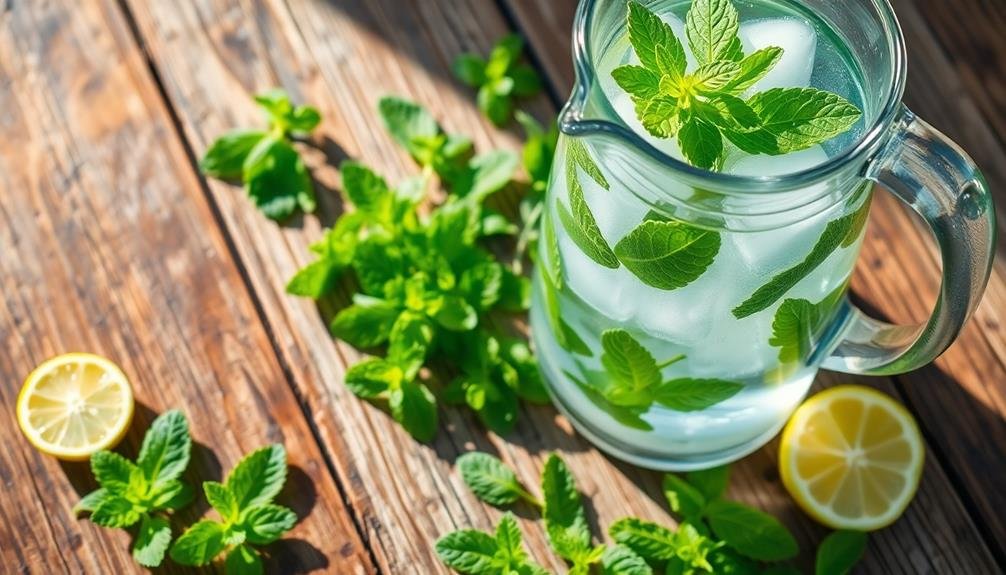
Refreshment takes center stage with fresh mint in summer tea blends. You'll find that mint's cooling properties make it an ideal herb for hot days. Whether you're using peppermint or spearmint, the leaves offer a burst of invigorating flavor that can transform your tea experience.
To incorporate fresh mint into your blends, start by gently crushing a few leaves to release their essential oils. Add them to your favorite black, green, or herbal tea base. For a purely minty infusion, steep the leaves alone in hot water for 3-5 minutes.
You can also experiment with cold brewing by letting mint leaves sit in cold water overnight in the refrigerator.
Don't limit yourself to just drinking mint tea. Try using it in creative ways, such as freezing mint leaves in ice cubes to add a revitalizing touch to iced tea. You can also muddle mint with sugar to create a flavorful syrup for sweetening your brews.
Chamomile: Spring's Calming Treasure
As spring blossoms unfold, chamomile emerges as a soothing star in seasonal tea blends. This daisy-like flower offers a gentle, apple-like flavor that perfectly complements the fresh, rejuvenating spirit of spring.
You'll find chamomile's calming properties particularly beneficial during this season of renewal and growth.
To harvest chamomile for your tea, pick the flowers when they're fully open on a dry, sunny day. Gently rinse and pat them dry before using fresh or drying for later use.
When brewing, steep 1-2 teaspoons of dried chamomile or 2-3 teaspoons of fresh flowers in hot water for 5-7 minutes.
Chamomile pairs wonderfully with other spring herbs like lemon balm, lavender, or rose petals. Try blending it with honey and a twist of lemon for a comforting bedtime tea.
You can also experiment by adding chamomile to iced teas or even cocktails for a unique, floral twist.
Beyond its delightful taste, chamomile is known for its potential to reduce anxiety, improve sleep quality, and aid digestion.
Autumn's Comforting Cinnamon Warmth
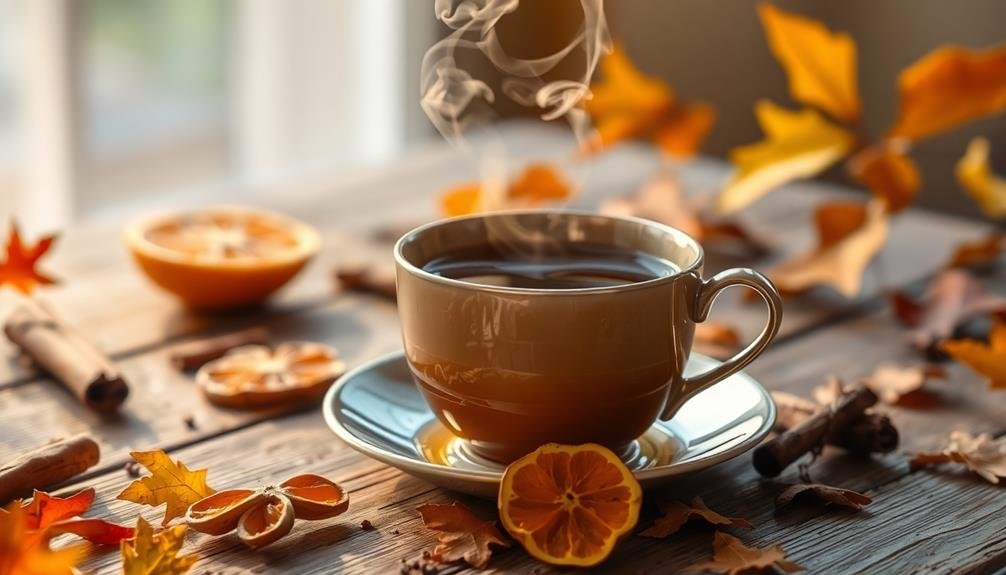
While spring offers the gentle embrace of chamomile, autumn brings its own comforting warmth in the form of cinnamon. This aromatic spice, derived from the inner bark of several tree species from the genus Cinnamomum, adds a distinctive flavor and aroma to your seasonal tea blends.
You'll find that cinnamon's sweet and spicy notes perfectly complement the crisp air and changing leaves of fall.
To incorporate cinnamon into your tea, you have several options. You can use cinnamon sticks for a more subtle flavor, allowing them to steep alongside your tea leaves. Alternatively, ground cinnamon can be sprinkled directly into your blend for a more intense taste.
Try pairing cinnamon with black teas like Assam or Ceylon for a robust autumn brew.
Beyond its delightful flavor, cinnamon boasts potential health benefits. It's rich in antioxidants and may help regulate blood sugar levels.
When creating your cinnamon-infused tea blend, consider combining it with other autumn favorites like apple pieces, cloves, or ginger for a truly seasonal experience.
Remember to start with small amounts and adjust to your taste preferences, as cinnamon's flavor can be quite potent.
Winter's Spicy Ginger Kick
The biting chill of winter calls for a tea that can warm you from the inside out. Enter ginger, the fiery root that'll kick your winter blues to the curb. This versatile spice isn't just for cooking; it's a powerhouse in tea blends, offering both flavor and potential health benefits.
When you're crafting your winter ginger tea, consider pairing it with complementary flavors to create a truly comforting brew. Here are four fantastic combinations to try:
- Ginger and lemon: A classic duo that'll boost your immune system
- Ginger and honey: Soothing for sore throats and coughs
- Ginger and turmeric: A golden, anti-inflammatory blend
- Ginger and cinnamon: A spicy-sweet combo that'll warm you to your toes
Don't be afraid to experiment with the strength of your ginger tea. Start with a small amount and gradually increase to find your perfect balance.
You can use fresh ginger root, sliced or grated, or opt for dried ginger pieces for convenience. Remember, ginger's heat can intensify as it steeps, so keep an eye on your brewing time to avoid overwhelming bitterness.
Lavender: A Year-Round Floral Delight
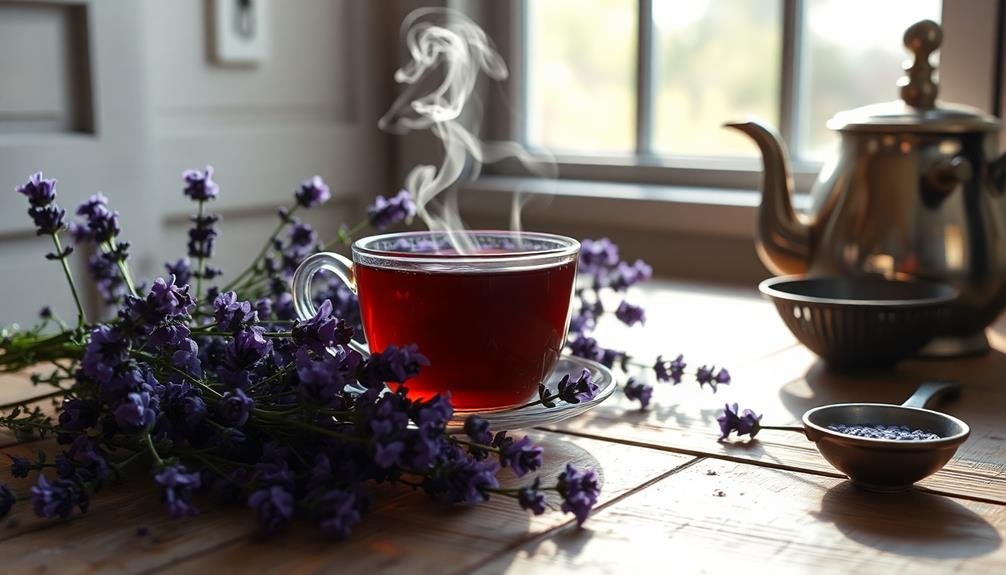
Few herbs can match lavender's versatility and year-round appeal in tea blends. You'll find this fragrant flower enhancing both hot and cold brews, adding a delicate floral note to your cup. Its calming properties make it perfect for evening teas, while its subtle flavor complements a variety of other herbs and fruits.
To incorporate lavender into your tea blends, start with small amounts and adjust to taste. You can use dried lavender buds or lavender-infused honey for a touch of sweetness. Here's a quick guide to lavender tea combinations:
| Season | Blend Ideas | Benefits |
|---|---|---|
| Spring | Lavender + Lemon Balm | Invigorating, calming |
| Summer | Lavender + Mint | Cooling, digestive aid |
| Fall | Lavender + Chamomile | Relaxing, sleep-promoting |
| Winter | Lavender + Vanilla | Comforting, stress-reducing |
| Year-round | Lavender + Green Tea | Antioxidant-rich, focus-enhancing |
Lemon Balm's Bright Citrus Notes
Shifting our focus from lavender's floral notes, let's explore another herb that brings a zesty punch to your tea blends. Lemon balm, with its bright citrus flavor, offers a revitalizing twist to your seasonal teas. This versatile herb thrives in summer, making it perfect for iced teas and cooling infusions.
You'll love lemon balm's ability to:
- Uplift your mood with its cheerful aroma
- Soothe digestive discomfort
- Support relaxation and reduce stress
- Boost cognitive function and memory
When harvesting lemon balm, pick the leaves just before the plant flowers for maximum flavor. You can use fresh leaves immediately or dry them for later use. To dry, hang small bunches in a warm, well-ventilated area away from direct sunlight.
Once dried, store the leaves in an airtight container.
Try pairing lemon balm with mint for an invigorating blend, or combine it with chamomile for a calming evening tea. You can also add a few leaves to black or green tea for a citrusy twist.
Don't be afraid to experiment – lemon balm's versatility makes it a welcome addition to countless tea combinations.
Rosemary: An Unexpected Aromatic Touch
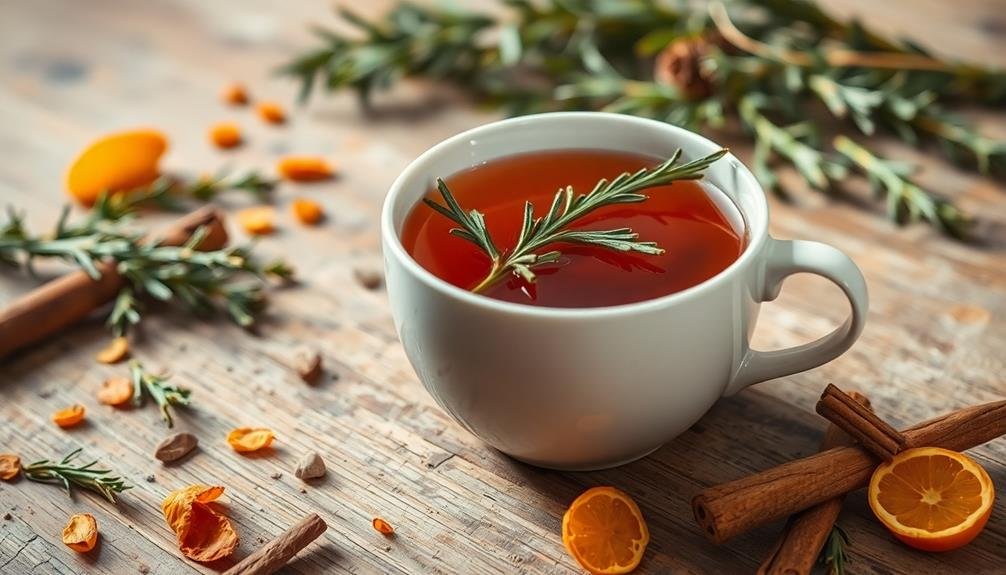
Rosemary's pine-like aroma and slightly bitter taste can add an unexpected depth to your tea blends.
You'll find this herb rich in antioxidants and potential memory-boosting properties.
Try pairing rosemary with citrus or mint for a revitalizing iced tea, or steep it with black tea for a warming winter brew.
Flavor Profile and Benefits
With its distinctive pine-like aroma, rosemary brings an unexpected twist to tea blends. You'll find its flavor profile to be bold and herbaceous, with notes of evergreen and a slightly peppery finish. This robust herb can add depth and complexity to your tea, especially when paired with citrus or mint flavors.
Rosemary isn't just about taste; it's packed with potential health benefits. When you incorporate rosemary into your tea, you're potentially:
- Boosting your cognitive function and memory
- Supporting your digestive system
- Enhancing your immune system
- Reducing inflammation in your body
You'll find that rosemary tea can be invigorating and revitalizing, making it an excellent choice for morning or midday blends. It's also caffeine-free, so you can enjoy it any time without worrying about sleep disruption.
To get the most out of rosemary in your tea, use fresh sprigs or dried leaves, and don't be afraid to experiment with different combinations. You might be surprised at how well this aromatic herb complements your favorite tea flavors while providing potential health benefits.
Pairing and Preparation Tips
Pairing rosemary in tea blends requires a delicate touch to balance its bold flavor. You'll find it pairs well with citrus herbs like lemon balm or lemongrass, creating a rejuvenating and invigorating blend.
For a more complex flavor profile, try combining rosemary with lavender or mint. These herbs complement rosemary's piney notes while adding their own unique characteristics.
When preparing rosemary tea, use fresh or dried leaves. For fresh rosemary, rinse the sprigs and gently bruise the leaves to release their oils. If using dried rosemary, crush the leaves slightly before steeping. Use about one teaspoon of dried rosemary or a 2-inch sprig of fresh rosemary per cup of water.
Steep rosemary tea for 5-10 minutes in water that's just below boiling (around 200°F). This temperature helps extract the herb's beneficial compounds without making the tea bitter.
For a stronger flavor, increase steeping time, but be cautious as it can become overpowering. Strain the tea before drinking and consider adding honey or lemon to taste. Remember, rosemary's potent flavor means a little goes a long way in your tea blends.
Frequently Asked Questions
How Long Can I Store Dried Herbs for Tea Blends?
You can store dried herbs for tea blends for up to a year if you keep them in airtight containers away from light, heat, and moisture. They'll retain their flavor and potency best when stored properly in a cool, dark place.
Are There Any Herbs I Should Avoid Mixing in Tea Blends?
You should avoid mixing herbs that can interact negatively or cause adverse effects. Don't blend St. John's Wort with other medications, and be cautious with comfrey, ephedra, and kava. Always research potential interactions before creating new tea blends.
Can I Use Fresh Herbs Instead of Dried Ones in Tea?
Yes, you can use fresh herbs in tea. They'll give your brew a vibrant flavor, but you'll need to use more than dried herbs. Remember, fresh herbs have higher water content, so adjust your measurements accordingly.
What's the Best Way to Measure Herbs for a Single Cup?
For a single cup, you'll typically use 1-2 teaspoons of dried herbs or 1-3 tablespoons of fresh herbs. You can adjust to taste, but start with these measurements and experiment until you find your perfect strength.
Are There Any Potential Side Effects of Drinking Herbal Teas Regularly?
While herbal teas are generally safe, you should be aware of potential side effects. They can interact with medications, cause allergic reactions, or have mild impacts like upset stomach. It's best to consult your doctor if you're concerned.
In Summary
You've now explored seven seasonal herbs that can transform your tea blends throughout the year. Whether you're seeking summer refreshment or winter warmth, there's an herb to suit every mood and season. Don't be afraid to experiment with combinations and ratios to find your perfect cup. Remember, fresh herbs often provide the most vibrant flavors, so consider growing your own tea garden. With these aromatic additions, you'll never have a dull tea moment again!


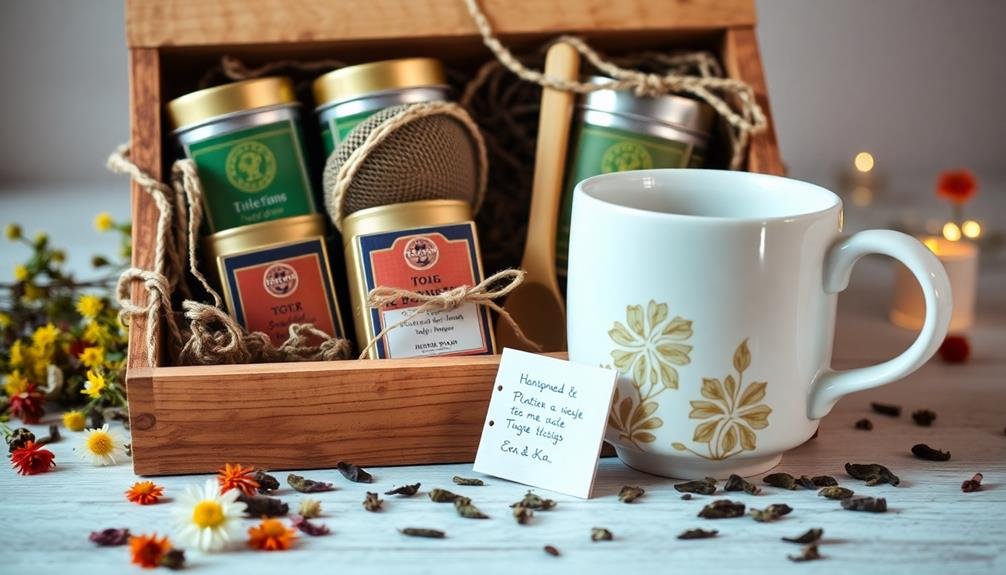
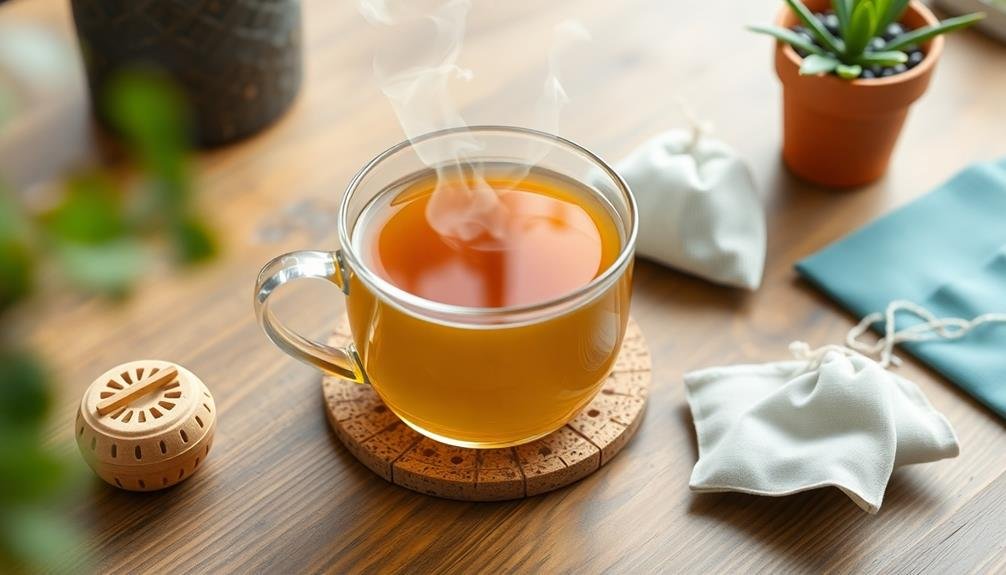
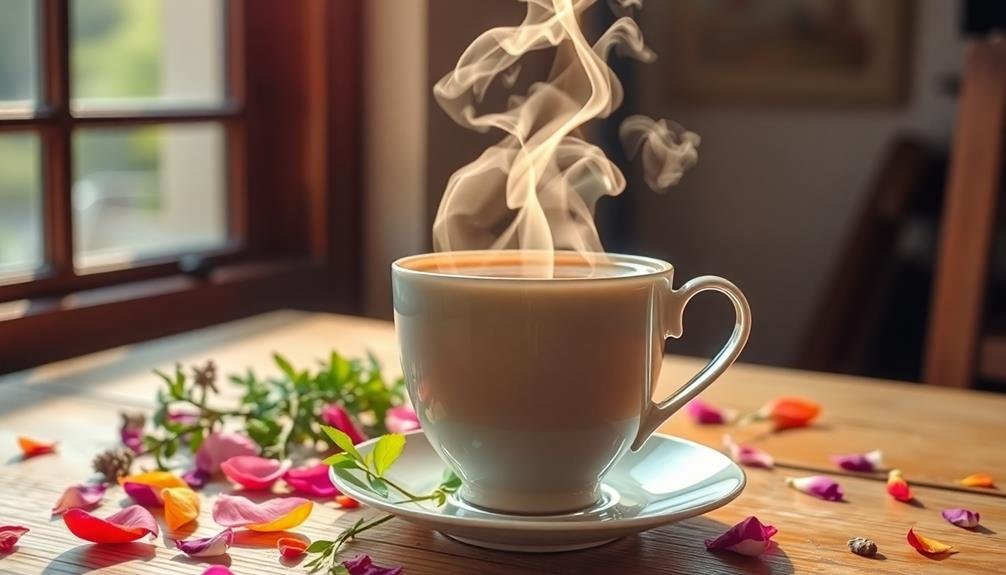
Leave a Reply